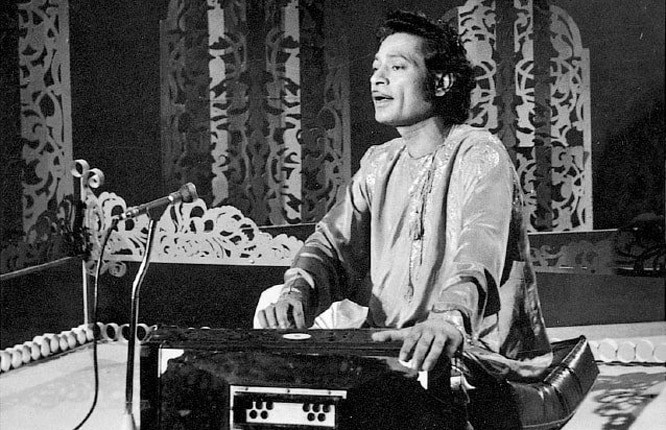
The death of Amanat Ali Khan was also the death of the old word of music

One heard the duo of Amanat Ali Khan and Fateh Ali Khan a lot in the decades of the 1960s and early seventies and imbibed their music. The two brothers appeared to strike a conjoined companionship in music but otherwise were poles apart temperamentally. Fateh Ali was methodical, careful, much disciplined and not swashbuckling at all.
Despite his stature and fame Amanat Ali Khan was extremely affable, very egregious and loved company. He relished exercising his wit, which he had like most musicians aplenty, and was expansive by temperament. He loved to talk, never about music or himself but about people in general, the political situation and the idiosyncrasies of various important personages who posed as patrons of music, but when he died on September 17, 1974 it appeared as if music had died with him.
Since he died young, in his forties, which can be considered the prime of a vocalist who specialised in kheyal and thumri the myth and romance associated with his life and singing has grown exponentially with years. And there was a good reason for it because he was an artiste in the traditional mould, reckless, flamboyant and a maverick to the hilt. He also lived a life which was measured in moments. He was not really bothered about investing in the future at the expense of sacrificing his present.
The only investment he made for the future was when he took his music education seriously along with his younger brother Ustad Fateh Ali Khan, monitored ruthlessly by his father Ustad Akhtar Hussain Khan. That was still the old world, when the education of musicians was conducted under the strict and at times brutal supervision of the elders of the family, and to a larger extent the women of the family, including mothers, only adding the necessary touch of love, sympathy and warmth as a counter to ruthless male discipline. But both the brothers owed a great deal to their mother who was very well educated and was exceptional in her knowledge and understanding of the finer aspects of music. Being the daughter of Ustad Payare Khan, she was extremely perceptive and conscientious about the obligation of transferring that knowledge to her sons.
Hailing from the famed Patiala Gharana, which had been founded by their grandfather Ustad Ali Buksh and his companion Ustad Fateh Ali Khan in the middle of the nineteenth century, they all travelled to Lahore at the time of independence. The decision to leave Patiala and come to Pakistan was taken abruptly by their father Ustad Akhtar Hussain Khan, and like most they arrived with only the clothes they were wearing and took up residence eventually on Fort Road.
The fame of these vocalists had preceded them to Lahore but they had to set up a new home and make a niche for themselves away from the relatively secure patronage of the Patiala state. These younger sons were able to do much better than their father in these changed conditions. Both emerged as the new stars on the horizon of classical music in the new state. But the circumstances had changed, the pattern of patronage had undergone a drastic transformation and the audiences too had become diverse. Amanat Ali Khan started to explore other forms more appreciated by the layman. Ironically, he is remembered more for the few ghazals and geets that he sang in the later years of his life than the kheyals or thumris, his real forte.
It was a decision forced by circumstances because the vocalists of the gharanas did not sing the ghazal and geet. They thought it was below them and strictly adhered to raagdari and protected jealously the particularities of the style of their gharana. By the nineteenth century, kheyal as a prestigious form had gained currency and dhrupad which had ruled the music world was seen to steadily decline. And the kheyal with its exponents represented the higher forms of music as everything else was supposed to be for the ordinary and the uninitiated.
Seeing the conditions Ustad Barre Ghulam Ali Khan left for India and the young Salamat Ali/Nazakat Ali survived the early years by singing the kaafi, while Roshan Ara Begum for years lived the anonymity of a housewife in Lalamusa. Musical knowledge was jealously guarded and the personalised transfer of music from the elder to the younger or from the ustad to the shagird was seen as an exclusive preserve of families of hereditary music. This system was supported by the ethos of the princely states which could be said to be the inheritors of the grand imperial rule in the sub-continent and during the colonial period were responsible for preservation of the traditional and indigenous forms.
Probably not enough credit has been given to these patrons, for without them the scene, particularly in the arts, would have been more imitative of the west than it had tended to become even then.
Pakistan changed all that as the cover of patronage was blown over and the understanding of the arts through the prism of theology created controversies which lay hidden beneath the surface but never interfered in the grand expression of either the empire or the principalities under its umbrella. The rise of and glorification of popular culture, greater international exposure and a crafted national identity changed the music scene forever, not always to its advantage. The break-up of Pakistan in 1971 also dealt a death blow to the classical forms as many more listened to this kind of music there in Bengal than here. The disappearance of initiated listeners, well-informed patrons and the primacy of commercial ratings of music numbers put an end to the ancient culture of music. The death of Amanat Ali Khan was also the death of the old word of music.